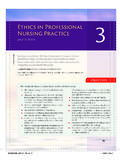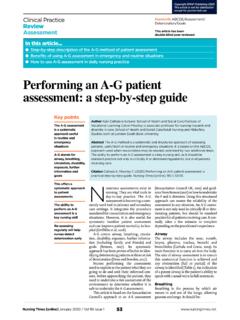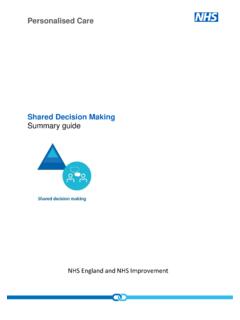Transcription of The matron s handbook
1 The matron s handbook For aspiring and experienced matrons Updated July 2021 1 | Contents Contents 2 Introduction .. 4 The matron s key 6 1. Inclusive leadership, professional standards and accountability 8 2. Governance, patient safety and quality .. 12 3. Workforce planning and resource management .. 17 4. Patient experience and reducing health inequalities .. 22 5. Performance and operational oversight .. 24 6. Digital and information technology .. 27 7. Education, training and development .. 33 8. Research and development .. 36 9. Collaborative working and clinical effectiveness .. 37 10. Service improvement and transformation .. 40 Appendix: The matron s developmental framework and 43 Acknowledgements .. 51 2 | Foreword Foreword Matrons are vital to delivering high quality care to patients and their relatives across the NHS and the wider health and care sector.
2 They are instrumental in promoting high standards of clinical care , reducing health inequalities and promoting equality for all, workforce retention and recruitment, staff education and development, compassionate, inclusive leadership and patient safety. The matron s role is the cornerstone of improving the quality of patient care . They do this through visible inclusive leadership and engagement with patients and families, frontline staff and senior management teams. Matrons provide key assurance to the board, providing evidence that the organisation is delivering safe care and supporting and developing staff to fulfil their roles. The matron s role spans all fields within the healthcare setting, including acute, community and mental health services. It seems apposite that we are launching this matron 's handbook in 2020, the International Year of the Nurse and Midwife.
3 This is a year we are celebrating commemorating and supporting the future of the professions. At my first Chief Nursing Officer s (CNO) summit I spoke about my priorities, the biggest being workforce ensuring a workforce fit for the future and celebrating all the work of #teamCNO. I see all nurses, midwives and care staff as members of this team. My second priority is raising the profile of nursing with renewed pride in what we do as professionals. I spoke of how immensely proud I am of the sheer breadth of our clinical, technical and academic excellence. I see evidence of this in every visit I make to services across England. My third priority is that we, as professionals, speak with a powerful collective #teamCNO #1professional voice, celebrating what we do and collectively forging the future direction of the nursing and midwifery professions.
4 Matrons in all health and care settings have a huge role to play in delivering these priorities and are critical to ensuring that people and populations access and receive high quality, safe care . They are critical to providing inclusive leadership and support for staff, empowering them to do what is right for all patients and 3 | Foreword families, to ensure safe and effective care while reducing inequality wherever it is seen. This matron s handbook is intended to highlight, reinforce and celebrate the critical role matrons play in health and care services across England. The handbook should be used to prepare staff as leaders for the matron s role and to support newly appointed matrons. Experienced matrons should use it to confirm their skills and support their development further.
5 This handbook is intended as a practical tool for matrons and their teams, and I hope you find it helpful. Thank you for all that you do every day for patients and for our profession. This matron s handbook was co-designed with matrons nationally and #teamCNO. Annesha Archyangelio wrote the handbook during her role as Nursing Fellow in Professional Leadership at NHS England and NHS Improvement. Ruth May Chief Nursing Officer for England 4 | Introduction Introduction This handbook is a practical guide for those who aspire to be a matron , those who are already in post and for organisations that want to support this important role. It can be used to prepare ward, department and service leaders for the matron s role and support newly appointed matrons. Experienced matrons should use the handbook to confirm their skills and help them prepare for their career development.
6 It identifies key aspects of the matron s role, with quality of care as the guiding principle. The handbook should be used by those working within the scope of the matron s role. This includes nurses, midwives and allied health professionals. Its purpose is to support matrons personal development, help matrons have an impact on senior healthcare leadership and encourage healthcare professionals to take up the matron s role. It aims to reinforce the importance of the matron s role in delivering high quality care using visionary skills, looking beyond the clinical skills needed for strategic inclusive leadership. An important element of the handbook concerns ethnic minority staff development. This is a national priority to ensure equality and diversity in the workforce. It is important because we recognise that our staff are our greatest asset, and when they feel supported and happy in work this positivity reaches those very people we are here for our patients .
7 We are committed to creating a fairer and more diverse NHS for everyone. One way we intend to support this is by developing and supporting ethnic minority staff and staff with any protected characteristic, to progress into senior roles. The matron s role in this is to contribute to addressing and solving problems for underrepresented and disadvantaged groups and individuals within their organisations, ensuring that the needs of the diverse workforce are met and health inequalities are addressed. This should be undertaken using the nationally and locally available resources to promote and facilitate this, which are available from 5 | Introduction the Workforce Race Equality Standard, NHS England and NHS Improvement, the Royal College of Nursing, NHS Leadership Academy, King s Fund, NHS Confederation and other networks and organisations.
8 Hilary Garratt CBE Deputy Chief Nursing Officer for England, Professional and System Leadership 6 | The matron s key roles The matron s key roles The matron s role has evolved since publication of the matron s 10 key responsibilities1 in 2003 and the matron s charter2 in 2004. Some aspects remain the same: for example, providing compassionate inclusive leadership and management to promote high standards of clinical care , patient safety and experience; prevention and control of infections; monitoring cleaning of the environment. Nevertheless, the role has grown to include workforce management, finance and budgeting, education and development, patient flow, performance management, digital technology and research. We consulted over 300 matrons at three national conferences, a 1,600-strong matron s network and over 40 subject experts who included national and local professionals from the CNO's team; Health Education England; the NHS Leadership Academy; King s Fund; Queen s Nursing Institute; Royal College of Nursing; healthcare trusts chief nurses and directors of nursing.
9 From this, the following key roles emerged: 1. Inclusive leadership, professional standards and accountability 2. Governance, patient safety and quality 3. Workforce planning and resource management 4. Patient experience and reducing health inequalities 5. Performance and operational oversight 6. Digital and information technology 7. Education, training and development 8. Research and development 9. Collaborative working and clinical effectiveness 10. Service improvement and transformation. These build on and modernise the 10 original roles identified in 2003. Furthermore, it has become evident that matrons do not take on full caseloads alone they work in a matrix style, delegating across wards, departments and services. They 1 Department of Health (2003) Modern matrons improving the patient experience.
10 London 2 +/ istics/Bulle tins/Chiefnursingofficerbulletin/Browsab le/DH_4954296 7 | The matron s key roles translate their trust s vision, mission and values into operational practice. They also support staff, especially new ward leaders, department and service managers. The NHS Long Term Plan3 and the Interim NHS People Plan4 stress the need for inclusive leadership and talent management. Matrons are crucial to achieving this. Message to matrons From Dr April Brown, Senior Clinical Lead, NHS England and NHS Improvement, who carried out doctoral research on the matron s role As you progress into and through your role as a matron : be bold and continually seek your academic limits work to the limit of your licence and be innovative seek forgiveness rather than permission for bold decisions always address it, don t walk past it and lead by example look and go outside and learn from others listen, hear and listen again to patients , their families and your staff acknowledge and identify barriers and work together to eliminate them.


















